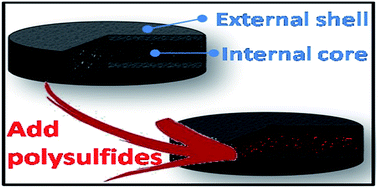A core–shell cathode substrate for developing high-loading, high-performance lithium–sulfur batteries†
Abstract
Lithium–sulfur batteries with a high theoretical energy density would be a promising next-generation energy-storage system if their cell-fabrication parameters (e.g., sulfur loading/content and the electrolyte/sulfur ratio) are improved to a practically necessary level. Herein, we report the design of a three-dimensional core–shell carbon substrate, integrating a porous internal core with a conductive external carbon nanofiber shell. Such a carbon substrate encapsulates a high amount of sulfur as the active material core to form a high-loading core–shell cathode, attaining an ultra-high sulfur loading and content of, respectively, 23 mg cm−2 and 75 wt%. With distinguishable internal and external regions, the carbon substrate facilitates the redox reactions and hinders the polysulfide diffusion. Thus, the core–shell cathodes exhibit a high areal capacity and energy density of, respectively, 14 mA h cm−2 and 27 mW h cm−2 during cycling. During resting, they achieve a long shelf-life of one month with a low capacity-fade rate of 0.25% per day.



 Please wait while we load your content...
Please wait while we load your content...